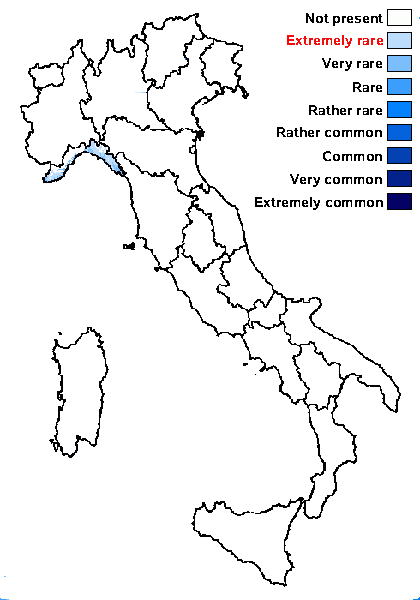Gyalecta sbarbari Vězda
Ann. zool. bot. Bratislava, 13: 6-7, 1965.
Synonyms:
Distribution: N - Lig (Breuss & Brand 2010, Spier 2011). S - Camp (Breuss & Brand 2010, Spier 2011), Cal (Breuss & Brand 2010, Spier 2011).
Description: Thallus crustose, thinly episubstratic, pale green or grey, often inconspicuous. Apothecia scattered, usually immersed, later sometimes becoming sessile, 0.3-0.7 mm across, with a yellow-orange, deeply concave, waxy disc and a smooth to radially cracked, creamy to brownish or yellowish pink proper margin. Epithecium hardly distinguishable from hymenium; hymenium colourless; paraphyses septate, not longer than the asci, capitate, the apical cells up to 3-4 µm wide; hypothecium colourless to pale yellow. Asci 8-spored, cylindrical to elongate-clavate, thin-walled, lacking an apical apparatus or tholus, the wall K/I+ blue. Ascospores submuriform to muriform, with 4-9 transverse septa, 1-3 longitudinal septa and 8-12 cells visible in optical view, hyaline, narrowly fusiform with rounded ends, 18-23 x 5.5-6.5(-7) µm. Photobiont trentepohlioid. Spot tests: K-, C-, KC-, P-, UV-. Chemistry: without lichen substances.Note: a rare species, also known from Austria. The type specimen was found on calcareous rocks in a humid-shaded site near the coast, but the typical substrate seems to be bark (Breuss & Brand 2010).
Growth form: Crustose
Substrata: bark and rocks
Photobiont: Trentepohlia
Reproductive strategy: mainly sexual
Commonnes-rarity: (info)
Alpine belt: absent
Subalpine belt: absent
Oromediterranean belt: absent
Montane belt: absent
Submediterranean belt: absent
Padanian area: absent
Humid submediterranean belt: extremely rare
Humid mediterranean belt: very rare
Dry mediterranean belt: absent

Predictive model
Growth form: Crustose
Substrata: bark and rocks
Photobiont: Trentepohlia
Reproductive strategy: mainly sexual
Commonnes-rarity: (info)
Alpine belt: absent
Subalpine belt: absent
Oromediterranean belt: absent
Montane belt: absent
Submediterranean belt: absent
Padanian area: absent
Humid submediterranean belt: extremely rare
Humid mediterranean belt: very rare
Dry mediterranean belt: absent

Predictive model
 INDEX FUNGORUM
INDEX FUNGORUM
 GBIF
GBIF

